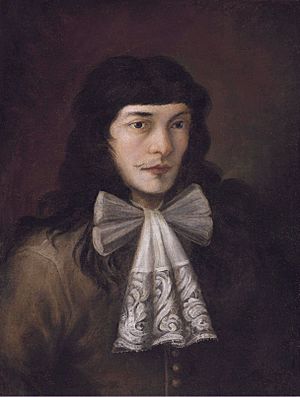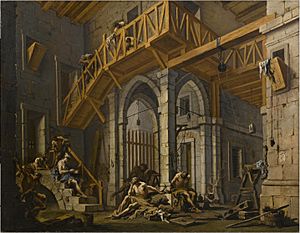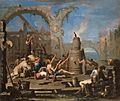Alessandro Magnasco facts for kids
Quick facts for kids
Alessandro Magnasco
|
|
|---|---|

Self-portrait
|
|
| Born | February 4, 1667 |
| Died | March 12, 1749 (aged 82) |
| Nationality | Italian |
| Education | Valerio Castello, Filippo Abbiati |
| Known for | Painting |
| Movement | Baroque |
Alessandro Magnasco (born February 4, 1667 – died March 12, 1749) was an Italian painter from the late Baroque period. He was also known as il Lissandrino. Magnasco worked mostly in the cities of Milan and Genoa.
He is famous for his unique and imaginative paintings. These often showed strange or dream-like scenes of everyday life or landscapes. Magnasco's special style used quick brushstrokes and bright flashes of light. This made his painted shapes look broken or "fragmented."
Contents
Life of Alessandro Magnasco
Alessandro Magnasco was born in Genoa, Italy. His father, Stefano Magnasco, was also an artist, but not as well known. Alessandro first learned painting from Valerio Castello. Later, he trained with Filippo Abbiati in Milan.
Magnasco worked in Milan for most of his life. However, he spent some years (from 1703 to 1709 or 1709 to 1711) in Florence. There, he worked for the Grand Duke Cosimo III. In 1735, he moved back to his hometown of Genoa.
Magnasco often worked with other artists. For example, he would paint people into the landscapes made by Carlo Antonio Tavella. He also added figures to the ruin scenes painted by Clemente Spera in Milan.
Magnasco's Painting Style
After 1710, Magnasco became very good at painting small pictures. These paintings often had dark and mysterious landscapes or old ruins. They also showed crowded indoor scenes.
The people in his paintings were usually small and looked a bit like cartoons. They were often thin and stretched out. He painted them with quick, flickering brushstrokes. These figures were often poor people dressed in torn clothes.
Magnasco painted many unusual subjects. These included church services, meetings of Quakers, groups of robbers, and scenes of questioning. It's not always clear what his feelings were about these topics.
A long time ago, people described him as a "romantic painter." They said he used "candid touches" and "ingenious expressiveness." He painted small figures in old churches or lonely hermits and monks. He also showed soldiers in their barracks.
An art expert named Luigi Lanzi said Magnasco's figures were "scarcely more than a span large." He added that they were "painted with humor and delight." Lanzi noted that important people in Florence liked these unique paintings.
Magnasco also had supporters in Milan. However, people in his hometown of Genoa did not like his bold style as much. They preferred paintings that were smoother and more detailed.
What Influenced Magnasco's Art
It's not fully clear what inspired Magnasco's special style. Some think he was influenced by the loose painting style of Sebastiano Ricci. Others suggest Domenico Piola and Gregorio de Ferrari from Genoa. However, it's also possible that these artists were influenced by Magnasco himself.
Magnasco might have been inspired by the emotional art of il Morazzone from Milan. Some of his paintings also remind people of Salvator Rosa's dramatic seascapes. Magnasco also liked painting scenes with robbers, similar to Rosa.
His small figures in large landscapes are like the airy paintings of Claude Lorraine. Magnasco's use of ragged beggars has been compared to Giuseppe Maria Crespi's style. But Crespi's figures were larger and more detailed.
Other possible influences include Italian painters who focused on everyday life. These were artists like the Roman Bamboccianti. Also, the detailed pictures by the French artist Jacques Callot might have inspired his unusual scenes.
Magnasco's Impact on Art
Magnasco's unique art style might have influenced other painters. These include Marco Ricci, Giuseppe Bazzani, and Francesco Maffei. He may also have inspired the famous Venetian painters Gianantonio Guardi and Francesco Guardi.
His paintings of questioning scenes, like The Inquisition, were unusual for Italian Baroque art. His pictures of Jewish and Quaker religious ceremonies were also not common. It is still a mystery how much "quietism" (a type of religious belief), criticism, or humor was in his paintings.
Selected Works
See also
 In Spanish: Alessandro Magnasco para niños
In Spanish: Alessandro Magnasco para niños














